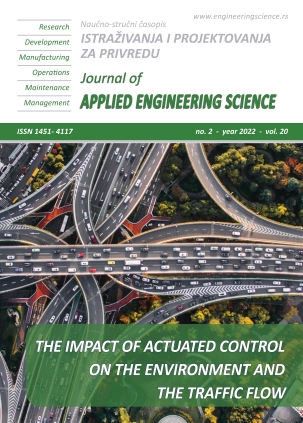SLIDING WEAR CHARACTERISTICS OF BORON CARBIDE AND NOVEL SQUID QUILL ASH REINFORCED ALUMINIUM 6061 HYBRID COMPOSITES
Abstract
Reinforcement of metallic and non-metallic particulates will enhance or improve the tribological and mechanical properties of metal matrix composites. In the present study, Aluminium 6061 was reinforced with agro-waste based novel Squid Quill Ash (SQA) and Boron Carbide (B4C) by employing a stir casting process. Sliding wear behavior of Al/B4C/SQA hybrid composites investigated by varying SQA content (0.5%, 1%, and 1.5%), sliding speed (400,500 and 600 RPM), and applied load (10,20 and 30 N) using Pin on Disc apparatus. Experiments were performed based on Taguchi L27 orthogonal design. The role of control parameters on wear rate was estimated using the Analysis of variance method. Statastical analysis showed that applied load has a significant effect on the wear rate of the hybrid composites followed by SQA content and Sliding Speed. Material removal during wear test mainly due to the combined effect of formation of cracks, abrasion, and grooves on the target surfaces.
References
Varshney, K. Kumar, Application and use of different aluminium alloys with respect to workability, strength and welding parameter optimization, Ain Shams Eng. J. 12 (2021) 1143–1152. doi:10.1016/j.asej.2020.05.013.
Brough, H. Jouhara, The aluminium industry: A review on state-of-the-art technologies, environmental impacts and possibilities for waste heat recovery, Int. J. Thermofluids. 1–2 (2020). doi:10.1016/j.ijft.2019.100007.
W. Lee, H.M. Lee, J.P. Wang, Chemical synthesis of aluminum chloride (AlCl3) by cost-effective reduction process, Rev. Adv. Mater. Sci. 28 (2011) 40–43.
Haghshenas, Metal–Matrix Composites, Ref. Modul. Mater. Sci. Mater. Eng. (2016) 0–28. doi:10.1016/b978-0-12-803581-8.03950-3.
N. Chethan, A. Pai, N.H. Padmaraj, A. Singhal, S. Sinha, Effect of bamboo char and boron carbide particles on mechanical characteristics of Aluminum 6061 hybrid composites, IOP Conf. Ser. Mater. Sci. Eng. 377 (2018) 012038. doi:10.1088/1757-899X/377/1/012038.
N. Chethan, A. Pai, N.H. Padmaraj, A. Singhal, S. Sinha, Effect of bamboo char and boron carbide particles on mechanical characteristics of Aluminum 6061 hybrid composites, IOP Conf. Ser. Mater. Sci. Eng. 377 (2018). doi:10.1088/1757-899X/377/1/012038.
Tisza, I. Czinege, Comparative study of the application of steels and aluminium in lightweight production of automotive parts, Int. J. Light. Mater. Manuf. 1 (2018) 229–238. doi:10.1016/j.ijlmm.2018.09.001.
K. Sankaran, R.S. Mishra, Aluminum Alloys, in: Metall. Des. Alloy. with Hierarchical Microstruct., Elsevier, 2017: pp. 57–176. doi:10.1016/B978-0-12-812068-2.00004-7.
Rishi, S.R. Chv, L.G. Keni, N.H. Padmaraj, K.N. Chethan, Mechanical characterization of aluminum 6061 with B4C and high entropy alloys, Int. J. Mech. Prod. Eng. Res. Dev. 9 (2019). doi:10.24247/ijmperdoct201946.
K. Sharma, R.C. Singh, R. Chaudhary, Effect of flyash particles with aluminium melt on the wear of aluminium metal matrix composites, Eng. Sci. Technol. an Int. J. 20 (2017) 1318–1323. doi:10.1016/j.jestch.2017.08.004.
N. Chethan, A. Pai, L.G. Keni, A. Singhal, S. Sinha, Fabrication and tribological response of aluminium 6061 hybrid composite reinforced with bamboo char and boron carbide micro-fillers, IOP Conf. Ser. Mater. Sci. Eng. 310 (2018). doi:10.1088/1757-899X/310/1/012028.
Surana, D.J. Pandya, N.H. Padmaraj, S. Hegde, K.N. Chethan, Influence of filler material on mechanical and vibration properties of basalt/epoxy composites, Mater. Res. Express. 6 (2019). doi:10.1088/2053-1591/ab279e.
O. Joseph, K.O. Babaremu, Agricultural waste as a reinforcement particulate for aluminum metal matrix composite (AMMCs): A review, Fibers. 7 (2019). doi:10.3390/fib7040033.
Q. Ochieze, C.C. Nwobi-Okoye, P.N. Atamuo, Experimental study of the effect of wear parameters on the wear behavior of A356 alloy/cow horn particulate composites, Def. Technol. 14 (2018) 77–82. doi:10.1016/j.dt.2017.11.001.
O. Babaremu, O.O. Joseph, E.T. Akinlabi, T.C. Jen, O.P. Oladijo, Morphological investigation and mechanical behaviour of agrowaste reinforced aluminium alloy 8011 for service life improvement, Heliyon. 6 (2020) e05506. doi:10.1016/j.heliyon.2020.e05506.
Singh, R.K. Mishra, B. Singh, Microstructural and mechanical characterization of lamb bone ash and boron carbide reinforced ZA-27 hybrid metal matrix composites, Proc. Inst. Mech. Eng. Part L J. Mater. Des. Appl. (2021). doi:10.1177/14644207211007506.
K. Alaneme, T.M. Adewale, P.A. Olubambi, Corrosion and wear behaviour of Al–Mg–Si alloy matrix hybrid composites reinforced with rice husk ash and silicon carbide, J. Mater. Res. Technol. 3 (2014) 9–16. doi:10.1016/j.jmrt.2013.10.008.
K. Alaneme, M.O. Bodunrin, A.A. Awe, Microstructure, mechanical and fracture properties of groundnut shell ash and silicon carbide dispersion strengthened aluminium matrix composites, J. King Saud Univ. - Eng. Sci. 30 (2018) 96–103. doi:10.1016/j.jksues.2016.01.001.
Periasamy, G.C. Mohankumar, Sea coral-derived cuttlebone reinforced epoxy composites: Characterization and tensile properties evaluation with mathematical models, J. Compos. Mater. 50 (2016) 807–823. doi:10.1177/0021998315581512.
ASTM International, Standard Test Method for Wear Testing with a Pin-on-Disk Apparatus, ASTM Int. 05 (2007) 1–5. doi:10.1520/G0099-17.Copyright.
Devadiga, P. Fernandes, Taguchi analysis for sliding wear characteristics of carbon nanotube-flyash reinforced aluminium nanocomposites, Heliyon. 7 (2021) e06170. doi:10.1016/j.heliyon.2021.e06170.
H. Padmaraj, K.M. Vijaya, Shreepannaga, U. Amritha, P. Dayananda, Slurry erosion behaviour of carbon/epoxy quasi-isotropic laminates based on Taguchi’s optimization method, Eng. Fail. Anal. 123 (2021) 105274. doi:10.1016/j.engfailanal.2021.105274.
Sathish, S. Karthick, Wear behaviour analysis on aluminium alloy 7050 with reinforced SiC through taguchi approach, J. Mater. Res. Technol. 9 (2020) 3481–3487. doi:10.1016/j.jmrt.2020.01.085.
Basavarajappa, G. Chandramohan, J. Paulo Davim, Application of Taguchi techniques to study dry sliding wear behaviour of metal matrix composites, Mater. Des. 28 (2007) 1393–1398. doi:10.1016/j.matdes.2006.01.006.
Stojanović, A. Vencl, I. Bobić, S. Miladinović, J. Skerlić, Experimental optimisation of the tribological behaviour of Al/SiC/Gr hybrid composites based on Taguchi’s method and artificial neural network, J. Brazilian Soc. Mech. Sci. Eng. 40 (2018). doi:10.1007/s40430-018-1237-y.
Udaya Prakash, S. Jebarose Juliyana, M. Saleem, T. V. Moorthy, Optimisation of dry sliding wear parameters of aluminium matrix composites (356/B4C) using Taguchi technique, Int. J. Ambient Energy. 42 (2021) 140–142. doi:10.1080/01430750.2018.1525590

